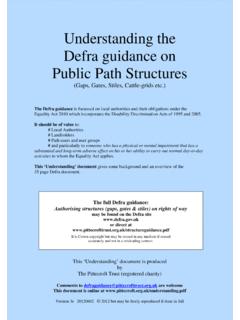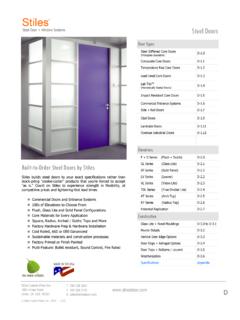Transcription of Understanding the British Standard for Gaps Gates and Stiles
1 Understanding the British Standard for Gaps Gates and Stiles BS5709:2018 explained The Standard covers gaps, pedestrian Gates , bridle Gates , kissing Gates , dog Gates , horse Stiles of two kinds, kent carriage gaps, and step over and flat top pedestrian Stiles . These explanatory pages cover ten rules applicable to all compliant structures. Examples are then given of a gap, a bridle/pedestrian gate, three kissing Gates and two Stiles . Rules specific to each structure type are shown beside them. The Standard also includes horse Stiles , other bridle Gates , dog Gates , horse step through Gates and the kent carriage gap. BS5709:2018 Explained version March 2018 mod 2 Produced to assist anyone involved with gaps Gates or Stiles : highways officer, path order maker, land owner, contractor, gate and stile manufacturer, path user and user group.
2 By The Pittecroft Trust (registered charity) and Tom Bindoff (a PDF version of this paper, which may include later updates, is at ) 2018 but may be freely reproduced if done in full The full Standard BS5709:2018 (ISBN 978 0 580 98210 1) is available from some libraries & bookshops and BSi British standards at 389 Chiswick High Road London W4 4AL Understanding the British Standard for Gaps Gates & Stiles 2 of 8 What are the key changes in the 2018 version? The needs of land managers have been made rather more explicit without losing sight of the overall need for the structures to be as least restrictive as practicable. The trial of self-closing bridle Gates at York in September 2015 has directed some changes, notably time-of-closure of these Gates and the need for enhanced visibility (yellow) of latches and handles.
3 Very few new requirements have been introduced, beyond the two in the paragraph above. But several requirements have been spelled out more explicitly, for example there is now a check-list for conformance with some key mandatory requirements at installation and regularly thereafter (in the new Section 8 of the Standard ). Some examples have changed. An illustration is given of a new type of bridle gate with a high-level ring latch. The trapezial kissing gate diagram has been dropped, a horse step-through gate has been added, the wide stile has been dropped and the narrow one made a little more stock-proof. Barbed wire restrictions have been slightly reduced but it remains banned from being closer than 1m from a structure, plants capable of doing harm can now come closer, 500mm, to a structure. Latches are now more closely defined and the throw-over loop (rope or chain) is now included.
4 The set-back distances from vehicular roads have been revised. The requirements for the surface quality at and near structures has been revised as has the ground-slopes for some structures. In some cases exceptions may be allowed but they now need to be documented with reasons. Some dimensions have changed eg minimum footpath gap width was 1m is now Bridle Gates must be minimum clear width , previously that was between posts (those authorised under earlier versions are exempt from the change). As a result of a fatality, there are extra requirements for the very few Gates weighing more than 80kg. And last but not least, the new version in the introduction and in a new Annex A tries to clarify the wording to be used when referring to the Standard in orders and other documents. What has not changed is the failure to explicitly define manoeuvring space, but it must be provided all the same.
5 Understanding the British Standard for Gaps Gates & Stiles 3 of 8 INTRODUCTION BS5709:2018 was drawn up by representatives of Natural England, CLA, NFU, OSS, BHS, Disabled Ramblers, IPROW, Highway Authority and a gate designer in a long process involving opportunity for public comment. It is, a s in the two previous versions, performance based. The act of choosing which structure is suitable for a given situation is itself a requirement of the Standard . Having made those choices, so long as the specified functional requirements and checks are met, then no matter what material is used in construction or what size or shape some parts of it may be, the conformance with the Standard will be satisfied. Ten key rules are described on the following pages, these rules are not referred to as such in the Standard but are used here as a checklist of the main requirements of the Standard .
6 Note the numbers do not correspond with the pre-2018 versions of this guide. At the public consultation stage of this revision it emerged that some people misunderstood and thought it would automatically apply to all existing structures. That is not so, it only applies where it is explicitly said to do so, for example in a path diversion order or a Highways Act s147 authorisation. DIMENSIONS The Standard is concerned only with the functionally relevant dimensions of the structures. So for example the clear width through Gates is specified but not their height or material. Note: in rare cases it may not be practicable to keep to all of the BS5709 requirements. The Standard can still be cited but with the exception spelled out. See in the Standard . This action is likely to be both better and simpler than not citing the BS at all and/or relying on some other local Standard .
7 Other relevant Pittecroft Trust publication: Understanding the Defra guidance on Public Path Structures The Defra guidance itself can be found at This document is aimed at enhancing Understanding of the principles and salient features of the Standard , for the full and authoritative details the official document, BS5709:2006 (ISBN 978 0 580 98210 1) should be consulted. History of this British Standard : First published for Stiles and Gates in 1979. The 2001 version was a major update. It included gaps. It moved from fixed designs to functional criteria. Countryside Commission, landowners, highway officers, user groups, manufacturers, all worked together on it. The 2006 version was a modest revision of the 2001 version. The 2018 version is a substantial re-write for clarity and for evenhandedness between the various people involved in implementing it.
8 It takes account of the bridlegate trials near York in 2014. Understanding the British Standard for Gaps Gates & Stiles 4 of 8 RULE 1: LEAST RESTRICTIVE OPTION FOR THE LAND MANAGEMENT NEEDS Least restrictive option must be chosen. The Standard s words are: The selection of a gap, gate or stile, which permits people to use a path crossing a boundary such as a hedge fence or stone wall, shall meet the needs of the land manager and shall cause as little restriction as possible for all lawful users. [ ] On public paths lawful users includes people of all ages and abilities, including users of mobility vehicles (wheelchairs and pushchairs) etc and dogs. There will be very few paths on which these users, including those with mobility vehicles, would not be able to travel, were it not for impassable structures. Just because other parts of the path are impassable to mobility vehicles perhaps because of existing Stiles , does not, under this Standard [ ], allow Stiles or non-mobility-vehicle-passable Gates to be put elsewhere on the path.
9 To do so would be to make it harder in future to give access for all. This is especially true of structures at the start of paths, where they leave a road. Some people with disabilities may get no further than the first field in the short term, but that is so much better than not getting anywhere at all. The Standard [Tables 1 and 2] lists various types of structure in order of accessibility for users, for footpaths that is basically Gap, Gate, Kissing Gate for mobility vehicles, plain Kissing Gate, Stile but is dependent on latching arrangements. So where something beyond a gap is needed then a two-way-opening self-closing gate is the preferred option (except adjoining roads where safety and vehicle exclusion may indicate a kissing gate suitable for mobility vehicles). Ideally the least restrictive is no structure at all and where there might be some other measure that would remove the need for any structure then that measure should be taken.
10 An example would be where some side fencing or rerouting of cattle paths might allow elimination of the need for any cattle barriers at all on the path [ c) Note 2]. Stiles . The s tandard also says new structures on public paths shall not be Stiles other than in exceptional circumstances [ ]. RULE 2: MANOEUVRING SPACE. [eg Note 2] This is the space needed to be kept clear so as to allow users to get into position to open, pass through, and close a gate or to negotiate a fixed structure. This is something that is a requirement of the Standard but was found too difficult by the writers of that Standard to specify clearly. A great deal more space is needed than is commonly assumed. One-way opening Gates need more manoeuvring space than two-way opening ones and some horses and mobility vehicles (wheel or pushchairs) may need a three metre diameter space [ Note].







